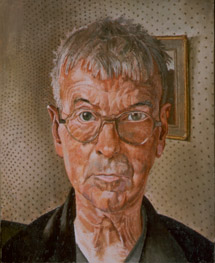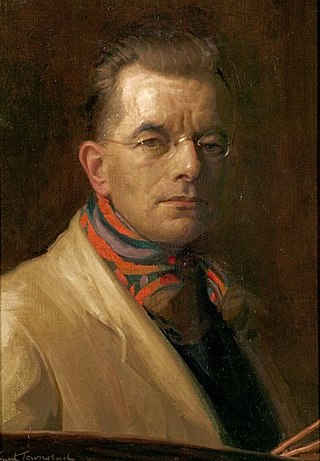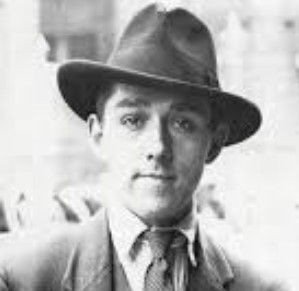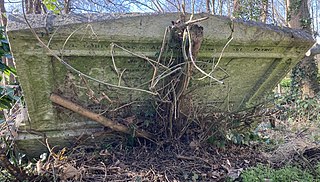
Sir Stanley Spencer, CBE RA was an English painter. Shortly after leaving the Slade School of Art, Spencer became well known for his paintings depicting Biblical scenes occurring as if in Cookham, the small village beside the River Thames where he was born and spent much of his life. Spencer referred to Cookham as "a village in Heaven" and in his biblical scenes, fellow-villagers are shown as their Gospel counterparts. Spencer was skilled at organising multi-figure compositions such as in his large paintings for the Sandham Memorial Chapel and the Shipbuilding on the Clyde series, the former being a First World War memorial while the latter was a commission for the War Artists' Advisory Committee during the Second World War.

Sir Frank William Brangwyn was a Welsh artist, painter, watercolourist, printmaker, illustrator, and designer.

David William Gentleman is an English artist. He studied art and painting at the Royal College of Art under Edward Bawden and John Nash. He has worked in watercolour, lithography and wood engraving, at scales ranging from platform-length murals for Charing Cross Underground Station in London to postage stamps and logos.

Cookham is a historic Thames-side village and civil parish on the north-eastern edge of Berkshire, England, 2.9 miles (5 km) north-north-east of Maidenhead and opposite the village of Bourne End. Cookham forms the southernmost and most rural part of the High Wycombe urban area. With adjoining Cookham Rise and Cookham Dean, it had a combined population of 5,779 at the 2011 Census. In 2011, The Daily Telegraph deemed Cookham Britain's second richest village.

Nicholas Pocock was an English artist known for his many detailed paintings of naval battles during the age of sail.

Louise Ingram Rayner was a British watercolour artist.

Norman Wilkinson was a British artist who usually worked in oils, watercolours and drypoint. He was primarily a marine painter, but also an illustrator, poster artist, and wartime camoufleur. Wilkinson invented dazzle painting to protect merchant shipping during the First World War.
Cyril Edward Power was an English artist best known for his linocut prints, long-standing artistic partnership with artist Sybil Andrews and for co-founding the Grosvenor School of Modern Art in London in 1925. He was also a successful architect and teacher.

Ernest Townsend was a British portraitist from Derby.
Claude Henry Buckle R.I., Royal Society for Marine Artists (R.S.M.A.) was an English painter well known for railway posters, carriage prints and for oil and watercolour paintings.

Gilbert Spencer was a British painter of landscapes, portraits, figure compositions and mural decorations. He worked in oils and watercolour. He was the younger brother of the painter Stanley Spencer.
Frank Henry Mason, RBA, RI, RSMA was an English artist best known for his maritime, shipping, coastal and harbour paintings, and as a creator of art deco travel and railway posters. His style is described as "light impressionist" and he was a founder member of the Staithes Art Club whose members are known today as the Staithes group of artists, or the Northern Impressionists.

Frank Parkinson Newbould was an English poster artist, known for his travel posters and Second World War posters for the War Office as assistant to Abram Games.
Kenneth Steel was a British painter and engraver, noted for his works of art in watercolor. As an accomplished draughtsman his work is noted for its intricate detail, which can be best seen in his landscapes views and street scenes, many of which were reproduced as designs for railway carriage prints and station billboard posters. Kenneth Steel was born in Sheffield, England to G. T. Steel, an artist and silver engraver. His elder brother, George Hammond Steel (1900–1960) was a successful landscape painter. Both brothers studied at Sheffield College of Art under Anthony Betts. During the 1920s Kenneth Steel studied briefly under the landscape artist, Stanley Royle, throughout their careers both artists remained close friends. Kenneth Steel supported and encouraged fellow Sheffield etcher, Leonard Beaumont. During World War II, both his mother, Annie and wife, Olive died during 'the Sheffield Blitz', victims of German bombing raids on the city during December 1940. His house took a direct hit resulting in the loss of much his work, designs and engraved plates. Throughout the late 1930's and early 1940s he wrote several important articles on the art of engraving, pencil drawing and watercolour technique for the art periodical, 'The Artist'.

Harold Gresley (1892–1967) was a British artist, following his father and grandfather. He was a painter of landscapes and portraits in watercolour and oil. He served in the Royal Fusiliers in the First World War and was awarded the Distinguished Conduct Medal. He has a substantial number of paintings in Derby Museum and Art Gallery.

George William Bissill was a British miner, painter, and furniture designer. Bissill's paintings are held in a number of important public collections, including the Tate Gallery, National Museum of Northern ireland and the Manchester Art Gallery. Bissill was known for his landscapes and figurative paintings in oil, watercolour and woodcuts.
For other people named John Platt, see John Platt.
Richard Barrett Talbot Kelly (1896–1971), MBE, MC, RI, known to friends and colleagues as 'TK', was a British army officer, school teacher, and artist, known especially for his watercolour paintings of ornithological subjects.
Leonard Richmond (1889-1965) was a Somerset born British watercolour landscape artist who spent a large part of his career in Canada ansd was noted for his railway posters.

Graham Petrie (1859-1940), was a British artist, poster designer, and author. He was well known for his landscape and travel posters for railway companies.











